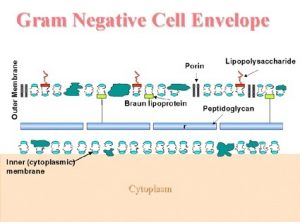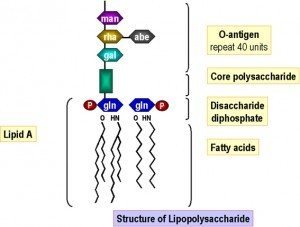 Lipopolysaccharide (LPS) Layer; the outer layer of cell wall of gram
negative bacteria is also called endotoxin. It is a characteristics
feature of Gram Negative Bacteria. As in peptidoglycan biosynthesis,
LPS molecules are assembled at the plasma or inner membrane.
Lipopolysaccharide (LPS) Layer; the outer layer of cell wall of gram
negative bacteria is also called endotoxin. It is a characteristics
feature of Gram Negative Bacteria. As in peptidoglycan biosynthesis,
LPS molecules are assembled at the plasma or inner membrane.Source: South Carolina School of Medicine
The LPS is composed of three distinct units.
- A phospholipid called Lipid A, which is responsible for toxic effects. Generally not released (and toxic) until death of cell.
Exception: N. meningitidis, which over-produces outer membrane fragments. - A core polysaccharide of fiver sugars linked through ketodeoxyoctulonate (KDO) to lipid A.
- An outer polysaccharide consisting of up to 25 repeating units of 3-5 sugars, also called somatic or O antigen. O antigens are used to identify certain organisms in microbiology laboratory.
- LPS activates macrophages, leading to release of TNF-alpha, IL- 1 , and IL-6.
- IL- 1 is a major mediator of fever.
- Macrophage activation and products lead to tissue damage.
- Damage to the endothelium from bradykinin-induced vasodilation leads to shock.
- Coagulation (DIC) is mediated through the activation of Hageman factor.



0 Comments:
Post a Comment